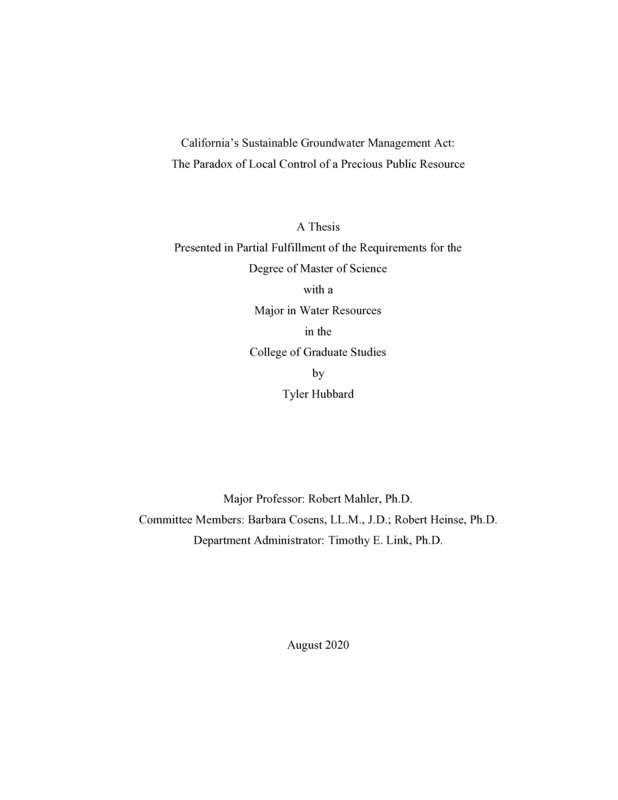California’s Sustainable Groundwater Management Act: The Paradox of Local Control of a Precious Public Resource
Hubbard, Tyler. (2020-06). California’s Sustainable Groundwater Management Act: The Paradox of Local Control of a Precious Public Resource. Theses and Dissertations Collection, University of Idaho Library Digital Collections. https://www.lib.uidaho.edu/digital/etd/items/hubbard_idaho_0089n_11908.html
- Title:
- California’s Sustainable Groundwater Management Act: The Paradox of Local Control of a Precious Public Resource
- Author:
- Hubbard, Tyler
- Date:
- 2020-06
- Program:
- Water Resources
- Subject Category:
- Water resources management; Water resources management
- Abstract:
-
Unlike most states west of the 100th meridian, California has, until recently, never enacted a comprehensive set of regulations to govern consumptive use of groundwater resources, even though groundwater provides between 40 percent and 60 percent of the water used by residents, farmers, business, and municipalities in the state. That changed in 2014, when the California legislature passed the Sustainable Groundwater Management Act (SGMA) in response to one of the worst droughts in the state’s history. The years between 2012 and 2014 had been so dry that surface water deliveries to the major agricultural areas of the San Joaquin Valley were cut to almost zero, forcing farmers to pump groundwater at unprecedented rates to make up the shortfall. This, in turn, caused groundwater levels to drop and domestic wells to go dry. SGMA was enacted to reverse this trend and bring the state’s groundwater resources into sustainability.
This thesis examines whether a key feature of SGMA – its focus on local control of groundwater management decisions – will frustrate the sustainability goals of the statute. By reviewing a representative sample of the Groundwater Sustainability Plans prepared in compliance with SGMA, the thesis analyzes how the local water agencies in the San Joaquin Valley differ in their approach to groundwater management when compared to local water agencies outside the San Joaquin Valley. This analysis indicates that much of the groundwater overdraft problem in California can be traced to a recent phenomenon where large farming interests in the San Joaquin Valley switched from annual row crops to permanent orchard crops, primarily almonds and pistachios. This change in crop mix has fundamentally altered water usage in the Valley, largely because almonds and pistachios require substantially more water than annual row crops.
Almonds and pistachios, however, are highly profitable, and the farmers who switched to these crops show no interest in converting back to row crops just to save water or improve conditions within their respective subbasin. For this reason, the Groundwater Sustainability Plans prepared by water agencies in the San Joaquin Valley focus almost exclusively on new water supply projects and include few provisions that would address pumping behavior or crop mix. Outside the San Joaquin Valley, however, the water agencies seem more willing to embrace a wide array of actions to achieve sustainability, including pumping restrictions and land fallowing programs. Thus, SGMA appears to create a two-tiered system, one in which San Joaquin Valley farmers can continue to pump as before, while the rest of the overdrafted basins in the state engage in aggressive cutbacks. Without greater guidance and enforcement from the State Water Resources Board and the Department of Water Resources, this two-tiered system may cause SGMA to fail in its objective, which is to bring all overdrafted subbasins, including those in the San Joaquin Valley, into a sustainable condition.
- Description:
- masters, M.S., Water Resources -- University of Idaho - College of Graduate Studies, 2020-06
- Major Professor:
- Mahler, Robert
- Committee:
- Cosens, Barbara; Heinse, Robert
- Defense Date:
- 2020-06
- Identifier:
- Hubbard_idaho_0089N_11908
- Type:
- Text
- Format Original:
- Format:
- application/pdf
- Rights:
- In Copyright - Educational Use Permitted. For more information, please contact University of Idaho Library Special Collections and Archives Department at libspec@uidaho.edu.
- Standardized Rights:
- http://rightsstatements.org/vocab/InC-EDU/1.0/

